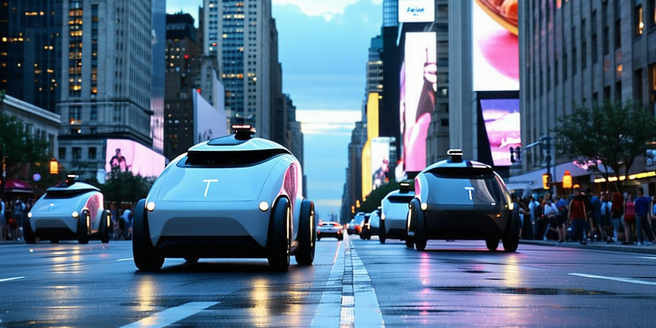Autonomous Vehicles And Urban Mobility

Understanding Autonomous Vehicles
Autonomous vehicles, often referred to as self-driving cars, are designed to navigate and operate without human intervention. These vehicles employ a combination of advanced sensors, cameras, radar, and artificial intelligence to perceive their surroundings and make decisions in real-time. The goal is to enhance safety, reduce human error, and improve transportation efficiency. To achieve full autonomy, vehicles must master complex driving environments and dilemmas. The transition from traditional to autonomous vehicles entails extensive testing and refinement of technologies. Public acceptance and understanding are crucial as misconceptions and apprehensions remain prevalent. Regulatory frameworks are also evolving to accommodate these innovations, ensuring that safety standards are met. As technology progresses, autonomous vehicles are set to transform the landscape of transportation, reshaping how we commute, interact with urban spaces, and view mobility.
The Evolution of Urban Mobility
Urban mobility has undergone significant changes over the past few decades, driven by technological advancements and shifting societal needs. Traditionally dominated by personal vehicles and public transit, cities are evolving toward more sustainable and efficient modes of transportation. The introduction of shared mobility services like ride-hailing, car-sharing, and micromobility options such as e-scooters and bikes has diversified urban mobility solutions. These innovations aim to reduce traffic congestion, lower emissions, and provide flexible, cost-effective transportation alternatives. As cities grow and populations increase, the demand for integrated and intelligent transportation systems becomes more pressing. Urban planners and policymakers are leveraging data and technology to optimize routes, manage traffic flow, and enhance connectivity. The evolution of urban mobility is fostering a more interconnected and resilient urban environment, prioritizing accessibility, sustainability, and the quality of urban life.
Benefits of Self-Driving Technology
Self-driving technology promises numerous benefits that could revolutionize transportation as we know it. One of the main advantages is improved safety; autonomous vehicles have the potential to significantly reduce accidents caused by human error, such as distracted or impaired driving. Additionally, they can enhance traffic efficiency and reduce congestion through better coordination and optimal route selection. The introduction of autonomous vehicles could also lead to increased mobility for those unable to drive, such as the elderly and disabled individuals, by providing easier access to transportation. Environmental benefits can arise as well, with the potential for reduced emissions through increased adoption of electric autonomous fleets. Moreover, self-driving technology can increase productivity by freeing up time during commutes, allowing passengers to work or relax. Overall, these advantages indicate a promising horizon for self-driving technology in the modern transportation landscape.
Challenges in Implementing Autonomous Systems
The implementation of autonomous systems, particularly in transportation, faces several significant challenges. One of the primary issues is ensuring safety and reliability in diverse driving environments, where vehicles must accurately interpret complex traffic scenarios and protocols. Additionally, there are technological hurdles, including perfecting sensor systems and ensuring robust cybersecurity to protect against hacking and data breaches. Public trust and acceptance also pose challenges; many are skeptical about placing their safety in the hands of machines, necessitating transparent communication and demonstrations of competence. Regulatory frameworks must evolve to address legal and ethical concerns, such as liability in the event of accidents. Infrastructure upgrades are essential to support autonomous vehicle integration, requiring significant investment and coordination. Addressing these challenges is critical to unlocking the full potential of autonomous systems and realizing their transformative impact on society.
Impact on Public Transportation Systems
Autonomous vehicles are anticipated to have a profound impact on public transportation systems. As autonomous technology evolves, it promises to complement existing transit networks by offering flexible, on-demand services that enhance last-mile connectivity. This evolution can lead to a more reliable and efficient public transportation system, with reduced wait times and better accessibility for commuters. Autonomous buses and shuttles have the potential to streamline operations, lower operational costs, and reduce emissions, contributing to more sustainable urban environments. However, the integration of autonomous vehicles within public transit also raises questions about employment, as automation might lead to job displacement among drivers. To address these challenges, policymakers and transit agencies must strategize on workforce transition programs while ensuring that transportation services remain equitable and affordable for all. The successful integration of autonomous technologies holds promise for revolutionizing public transit systems globally.
The Future of Urban Mobility and Smart Cities
The future of urban mobility is intrinsically linked to the development of smart cities. As urban areas continue to grow, integrating intelligent transportation systems becomes paramount to managing congestion and enhancing the quality of life. Smart cities leverage technology and data-driven solutions to create interconnected urban ecosystems where transportation networks communicate seamlessly with infrastructure. Developments in autonomous vehicle technology, IoT, and AI play pivotal roles in this transformation. By enabling real-time data sharing, cities can optimize traffic flow, provide dynamic public transit schedules, and improve safety. Citizen-engagement platforms foster collaboration between urban residents and city planners, ensuring that mobility solutions reflect the needs of the community. The vision of the future involves clean, efficient, and resilient urban systems that prioritize sustainability and innovation. Embracing this future requires collaboration across sectors to innovate and implement strategies that drive sustainable urban growth.